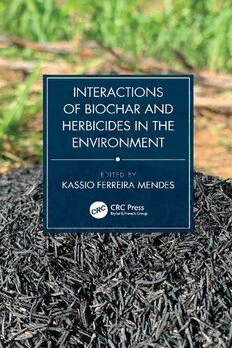Table Of ContentInteractions of Biochar
and Herbicides in the
Environment
Interactions of Biochar
and Herbicides in the
Environment
Edited by
Kassio Ferreira Mendes
First edition published 2022
by CRC Press
6000 Broken Sound Parkway NW, Suite 300, Boca Raton, FL 33487–2742
and by CRC Press
4 Park Square, Milton Park, Abingdon, Oxon, OX14 4RN
CRC Press is an imprint of Taylor & Francis Group, LLC
© 2022 Taylor & Francis Group, LLC
Reasonable efforts have been made to publish reliable data and information, but the
author and publisher cannot assume responsibility for the validity of all materials or
the consequences of their use. The authors and publishers have attempted to trace
the copyright holders of all material reproduced in this publication and apologize to
copyright holders if permission to publish in this form has not been obtained. If any
copyright material has not been acknowledged please write and let us know so we
may rectify in any future reprint.
Except as permitted under U.S. Copyright Law, no part of this book may be reprinted,
reproduced, transmitted, or utilized in any form by any electronic, mechanical, or
other means, now known or hereafter invented, including photocopying, microfilming,
and recording, or in any information storage or retrieval system, without written
permission from the publishers.
For permission to photocopy or use material electronically from this work, access
www.copyright.com or contact the Copyright Clearance Center, Inc. (CCC), 222
Rosewood Drive, Danvers, MA 01923, 978–750–8400. For works that are not
available on CCC please contact [email protected]
Trademark notice: Product or corporate names may be trademarks or registered
trademarks and are used only for identification and explanation without intent to
infringe.
ISBN: 978-1-032-06397-3 (hbk)
ISBN: 978-1-032-06375-1 (pbk)
ISBN: 978-1-003-20207-3 (ebk)
DOI: 10.1201/9781003202073
Typeset in Times
by Apex CoVantage, LLC
Contents
Preface ���������������������������������������������������������������������������������������������������������������������� vii
Editor� ������������������������������������������������������������������������������������������������������������������������ ix
List of Contributors ��������������������������������������������������������������������������������������������������� xi
List of Abbreviations ���������������������������������������������������������������������������������������������� xvii
Chapter 1 Agricultural Applications of Biochar ��������������������������������������������������� 1
Mingxin Guo and Weiping Song
Chapter 2 Biochar Production, Properties, and Its Influencing Factors �������������� 23
Tiago Guimarães and Renata Pereira Lopes Moreira
Chapter 3 Influence of Herbicide Environmental Behavior on Weed
Management ��������������������������������������������������������������������������������������� 53
Rafael De Prado, Candelario Palma- Bautista, José Guadalupe
Vázquez- García, and Ricardo Alcántara- de la Cruz
Chapter 4 Interaction Mechanisms Between Biochar and Herbicides ���������������� 79
Rodrigo Nogueira de Sousa, Matheus Bortolanza Soares,
Felipe Hipólito dos Santos, Camille Nunes Leite, and
Kassio Ferreira Mendes
Chapter 5 Effects of Biochars on Sorption and Desorption of Herbicides
in Soil ����������������������������������������������������������������������������������������������� 131
Kamila Cabral Mielke, Kassio Ferreira Mendes,
and Tiago Guimarães
Chapter 6 Effect of Biochar on Soil Herbicide Transport ��������������������������������� 167
Daniel Valadão Silva, Tatiane Severo Silva, Bruno Caio Chaves
Fernandes, Taliane Maria da Silva Teófilo, Francisca Daniele
da Silva, and Kassio Ferreira Mendes
Chapter 7 Effects of Biochar on Degradation Herbicides in the Soil ��������������� 189
Vanessa Takeshita, Fernando Sarmento de Oliveira, Gustavo
Vinícios Munhoz- Garcia, Bruno Caio Chaves Fernandes,
Taliane Maria da Silva Teófilo, Kassio Ferreira Mendes, and
Valdemar Luiz Tornisielo
v
vi Contents
Chapter 8 Impacts of Biochar Addition on Herbicides’ Efficacy for Weed
Control in Agriculture ...................................................................... 219
Gabriel da Silva Amaral, Manuel Alejandro Ix-B alam, Kassio
Ferreira Mendes, Maria Fátima das Graças Fernandes da Silva,
and Ricardo Alcántara-d e la Cruz
Chapter 9 Removal of Herbicides from Water Using Biochar .......................... 251
Widad El Bouaidi, Ghizlane Enaime, Mohammed Loudiki,
Abdelrani Yaacoubi, Mountasser Douma, and Manfred Lübken
Index...................................................................................................................... 273
Preface
The use of herbicides is a fundamental part of the current agricultural model, and
without the use of these products it would likely be unfeasible to guarantee food
security worldwide. On the other hand, these products have a series of environmen
tal and social impacts, which demand a constant concern on the part of society. Soil
is the final fate of herbicides applied in agriculture in the soil–plant system. When
they come into contact with the soil, herbicides are subject to a series of physical–
chemical processes that regulate their fate and behavior in the environment, which is
extremely complex. The use of biochar in agricultural soils as fertilizer and soil con
ditioner has been further explored; however, little is known about the effect of this
material on soils contaminated with herbicides, and little is known about its effect
on weed control as well. The fate and environmental behavior of certain herbicides,
as well as their efficacy when applied directly to the soil, such as pre- emergent her
bicides with residual action, are strongly influenced by the retention bond with soil
particles and organic carbon content. Therefore, the addition of biochar to the soil
can easily potentiate the herbicide retention process, which, in addition to contrib
uting positively to the reduction of chemical contaminants in the environment, can
exert negative effects on herbicide behavior and effectiveness of these products in
weed control. Thus, this book highlights the physical and chemical characteristics of
biochar, which can impact on the sorption–desorption, runoff, leaching, and hence
efficacy and degradation of herbicides. Furthermore, the removal of herbicides in
water is also evidenced with the addition of biochar.
vii
Editor
Dr. Kassio Ferreira Mendes is Professor of Biology and Integrated Management of
Weed, Department of Agronomy, Federal University of Viçosa, Brazil; Post-D octor
(2019) and Doctor (2017) in Science – Nuclear Energy in Agriculture (Chemistry
in Agriculture and Environment) by Center of Nuclear Energy in Agriculture,
University of São Paulo, Brazil with interuniversity exchange doctorate University
of Minnesota, USA (2016), Twin Cities Campus – College of Food and Agricultural
Sciences in the Department of Soil, Water, and Climate. Master in Agronomy (Crop
Science) by Federal University of Viçosa (2013); Agronomist by University of State
Mato Grosso (2011); Member of Brazilian Society of Weed Science.
ix

